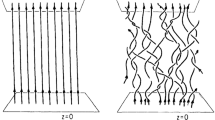Abstract
In this article, we investigate the possibility of transient growth in the linear perturbation of current sheets. The resistive magnetohydrodynamics operator for a background field consisting of a current sheet is non-normal, meaning that associated eigenvalues and eigenmodes can be very sensitive to perturbation. In a linear stability analysis of a tearing current sheet, we show that modes that are damped as \(t\rightarrow \infty \) can produce transient energy growth, contributing faster growth rates and higher energy attainment (within a fixed finite time) than the unstable tearing mode found from normal-mode analysis. We determine the transient growth for tearing-stable and tearing-unstable regimes and discuss the consequences of our results for processes in the solar atmosphere, such as flares and coronal heating. Our results have significant potential impact on how fast current sheets can be disrupted. In particular, transient energy growth due to (asymptotically) damped modes may lead to accelerated current sheet thinning and, hence, a faster onset of the plasmoid instability, compared to the rate determined by the tearing mode alone.





Similar content being viewed by others
References
Abramowitz, M., Stegun, I.A. (eds.): 1964, Handbook of Mathematical Functions, Dover, New York.
Bobra, D., Riedel, K.S., Kerner, W., Huysmans, G.T.A., Ottaviani, M., Schmid, P.J.: 1994, Phys. Plasmas 1, 3151.
Camporeale, E.: 2010, Space Sci. Rev. 172, 397.
Camporeale, E., Burgess, D., Passot, T.: 2009, Phys. Plasmas 16, 030703.
Chandrasekhar, S.: 1961, Hydrodynamic and Hydromagnetic Stability, Clarendon, Oxford.
Comisso, L., Lingam, M., Huang, Y.-M., Bhattacharjee, A.: 2016, Phys. Plasmas 23, 100702.
Farrell, B.F., Ioannou, P.J.: 1999a, Astrophys. J. 522, 1079.
Farrell, B.F., Ioannou, P.J.: 1999b, Astrophys. J. 522, 1088.
Furth, H.P., Kileen, J., Rosenbluth, M.N.: 1963, Phys. Fluids 6, 459.
Goedbloed, J.P., Keppens, R., Poedts, S.: 2010, Advanced Magnetohydrodynamics, Cambridge University Press, Cambridge.
Hanifi, A., Schmid, P.J., Henningson, D.S.: 1996, Phys. Fluids 8, 826.
Hood, A.W., Hughes, D.W.: 2011, Phys. Earth Planet. Inter. 187, 78.
Hood, A.W., Cargill, P.J., Browning, P.K., Tam, K.V.: 2016, Astrophys. J. Lett. 817, 5.
Lapenta, G.: 2008, Phys. Rev. Lett. 100, 235001.
Livermore, P.W., Jackson, A.: 2006, Proc. Roy. Soc. A 462, 2457.
Lourerio, N.F., Schekochihin, A.A., Cowley, S.C.: 2007, Phys. Plasmas 14, 100703.
MacNeice, P., Antiochos, S.K., Phillips, S., Spicer, D.S., DeVore, C.R., Olson, K.: 2004, Astrophys. J. 614, 1028.
MacTaggart, D., Haynes, A.L.: 2014, Mon. Not. Roy. Astron. Soc. 438, 1500.
MacTaggart, D., Guglielmino, S.L., Haynes, A.L., Simitev, R.D., Zuccarello, F.: 2015, Astron. Astrophys. 576, A4.
Parker, E.N.: 1988, Astrophys. J. 330, 474.
Priest, E.R.: 2014, Magnetohydrodynamics of the Sun, Cambridge University Press, Cambridge.
Pritchett, P.L., Lee, Y.C., Drake, J.F.: 1980, Phys. Fluids 23, 1368.
Pucci, F., Velli, M.: 2014, Astrophys. J. Lett. 780, L19.
Reddy, S.C., Henningson, D.S.: 1993, J. Fluid Mech. 252, 209.
Reddy, S.C., Schmid, P.J., Henningson, D.S.: 1993, SIAM J. Appl. Math. 53, 15.
Schindler, K.: 2006, Physics of Space Plasma Activity, Cambridge University Press, Cambridge.
Schmid, P.J., Henningson, D.S.: 1994, J. Fluid Mech. 277, 197.
Tassi, E., Hastie, R.J., Porcelli, F.: 2007, Phys. Plasmas 14, 9.
Tenerani, A., Rappazzo, A.F., Velli, M., Pucci, F.: 2015, Astrophys. J. 801, 145.
Tenerani, A., Velli, M., Pucci, F., Landi, S., Rappazzo, A.F.: 2016, J. Plasma Phys. 82, 535820501.
Terasawa, T.: 1983, Geophys. Res. Lett. 10, 475.
Tichmarsh, E.C.: 1948, Introduction to the Theory of Fourier Integrals, Oxford University Press, London.
Trefethen, L.N., Bau, D.: 1997, Numerical Linear Algebra, SIAM, Philadelphia.
Trefethen, L.N., Embree, M.: 2005, Spectra and Pseudospectra: The Behaviour of Nonnormal Matrices and Operators, Princeton University Press, Princeton.
Author information
Authors and Affiliations
Corresponding author
Ethics declarations
Disclosure of Potential Conflicts of Interest
The authors declare that they have no conflicts of interest.
Appendix
Appendix
Throughout this article, we have performed calculations with boundary conditions \(u=b=0\) at \(x=\pm d\). This has been done so that our results can be easily compared to other works and to nonlinear simulations, which typically use such boundary conditions. Since the tearing instability develops in a boundary layer near \(x=0\), the precise nature of the boundary conditions should not play a strong role in the onset of the instability. To illustrate this, we solve the discrete form of Equation 23, with \(S=1000\) and \(k=0.5\), in the half-plane and compare the resulting spectrum to that in Figure 1a.
Anticipating a symmetric solution in \(\boldsymbol{b}\) and an antisymmetric solution in \(\boldsymbol{u}\) about \(x=0\), we set the boundary conditions at \(x=0\) to be
As \(x\rightarrow \infty \), we set
In order to represent this boundary numerically, we consider a large domain denoted by \(0\le x\le x_{\mathrm{max}}\). In order to expand the variables using Chebyshev polynomials, we need to map our coordinates to the domain \(-1\le y \le 1\). This is achieved through
where
This mapping clusters the grid points near the boundary layer at \(x=0\) and places half of the grid points in the region \(0\le x\le x_{i}\) (Hanifi, Schmid, and Henningson, 1996). In this example, we take \(x_{\mathrm{max}}=100\) and \(x_{i}=15\). The resulting spectrum is displayed in Figure 6.
By inspection, the comparison with Figure 1a yields few differences. The eigenvalue corresponding to the tearing mode now has a value \({\approx}\, 0.0111\), which is still similar to that calculated for the other boundary conditions. Two isolated eigenvalues near \(\Im (\omega )=0\) in Figure 1a are now pushed nearer the main branches in Figure 6. Apart from these minor differences, the spectra calculated from different boundary conditions are very similar. This result suggests that the exact form of boundary conditions, assuming they do not interfere dynamically with the boundary layer at \(x=0\), will not radically change the behavior of the onset of the tearing instability.
Rights and permissions
About this article
Cite this article
MacTaggart, D., Stewart, P. Optimal Energy Growth in Current Sheets. Sol Phys 292, 148 (2017). https://doi.org/10.1007/s11207-017-1177-1
Received:
Accepted:
Published:
DOI: https://doi.org/10.1007/s11207-017-1177-1





